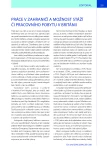BLADDER SPARING TREATMENT FOR MUSCLE-INVASIVE BLADDER CANCERS
Authors:
Boris Eliáš; Roman Tomaškin; Ján Kliment, ml.; Ján Šulgan; Ján Kliment
Authors‘ workplace:
Urologická klinika, Jesseniová lekárska fakulta Univerzity Komenského a Martinska fakultná
nemocnica, Martin
Published in:
Ces Urol 2016; 20(4): 309-316
Category:
Original Articles
Overview
Objectives:
The aim of this study was to evaluate treatment outcomes of muscle-invasive bladder cancers treated with radical TURB followed by adjuvant chemotherapy, radiotherapy, or their combination in order to preserve functional bladder.
Material and methods:
We retrospectively evaluated patients with muscle-invasive urothelial tumors who were treated at the Department of Urology in Martin from 2005–2016 by radical TURB followed by adjuvant therapy. If histological examination confirmed invasive urothelial carcinoma (pT2a-pT2b) all such patients underwent re-TURB. In the analysis were included only patients who had negative histology (pT0) after re-TURB, the primary solitary tumor was ≤3 cm in size, ureterohydronephrosis was not present, not the presence of diffuse CIS and there was no tumor invaded outside the bladder wall. Thereafter, patients were treated with adjuvant chemotherapy, radiotherapy or their combination. Statistically, we evaluated baseline characteristics of the patients, adjuvant therapy, recurrence rate and overall survival.
Results:
The cohort of 14 patients aged 54–69 years (mean 61 years) consisted of 7 women and 7 men. All of the patients after radical TUR-B had confirmed invasive urothelial carcinoma pT2a-pT2b, G2-G3 After re-TURB no patient had residual tumor from the base (pT0), one patient had CT verified enlargement of obturator LN up to 3 cm. Adjuvant chemotherapy as a monotherapy underwent 6 (42 %) patients, 7 (50 %) underwent concomitant chemoradiotherapy and 1 (8 %) patient refused any treatment. Local recurrence of muscle-invasive bladder tumor was not present in none of the patients, 1 (8 %) patient surgically removed obturator LN (confirmed metastasis) after two years, 3 (21 %) patients had a recurrence of a non-invasive high-grade urothelial carcinoma pT1, G3. 13 (92 %) patients are surviving 1–11 years (median 6 years), no patient has died because of disease progression, 1 (8 %) patient died due to MI.
Conclusion:
The results of our limited study suggest, that in well- selected patients with muscle invasive transitional cell bladder cancers (pT0 after re-TURB) after trimodal therapy we can achieve complete response with minimal risk of local or systemic progression and long-term cancer specific- free survival. It requires multidisciplinary collaboration of urologist, radiation oncologist and medical oncologist as well as close cooperation of patients who require regular long-term cystoscopic and CT / MR surveillance because of a risk of local or systemic recurrence.
Key words:
Muscle-invasive bladder cancers, TURB, chemoradiotherapy, trimodality therapy, bladder sparing, bladder preservation.
Sources
1. Rodel C, Weiss Ch. Organ – sparing multimodality treatment for muscle- invasive bladder cancer: Can we continue to ignore the evidence? J Clin Oncol. 2014; 32: 3787–3789.
2. Gakis G, Efsthatiou J, Lerner SP, et al. ICUD-EAU International Consultation on Bladder Cancer 2012. Radical cystectomy and bladder preservation for muscle-invasive urothelial carcinoma of the bladder. Eur Urol, 2013; 63: 45–57.
3. El Khalil SA. Long term complications following ileal conduit urinary diversion after radical cystectomy. J Egypt Natl Canc Inst, 2010; 22: 13–18.
4. Aghazadeh MA, Barocas DA, Salem S, et al. Determining factors for hospital discharge status after radical cystectomy in a large contemporary cohort. J Urol, 2011; 185(1): 85–89.
5. El-Taji OMS, Alam MS, Hussain SA. Bladder sparing approaches for muscle – invasive bladder cancers. Curr Treat Options in Oncol, 2016; 17: 1–14.
6. Stein JP, Lieskovsky G, Cote R, et al. Radical cystectomy in the treatment of invasive bladder cancer: long-term results in 1 054 patients. J Clin Oncol. 2001; 19: 666–675.
7. Bentzen SM, Harari PM, Bernier J. Exploitable mechanisms for combining drugs with radiation: concepts, achievments and future directions. Nat Clin Pract Oncol. 2007; 4(3): 172–180.
8. Grob BM, Macchia RJ. Radical transurethral resection in the management of muscle-invasive bladder cancer. J Endourol. 2001; 15(4): 419–423.
9. Efstathiou JA, Spiegel DY, Shipley WU, et al. Long-term outcomes of selective bladder cancer: the MGH experience. Eur Urol. 2012; 61: 705–711.
10. Volkmer BG, Kuefer R, Bartsch G Jr, et al. Effect of a pT0 cystectomy specimem without neoadjuvant therapy on survival. Cancer. 2005; 104(11): 2384–2391.
11. Rodel C, Grabenauer GG, Kuhn R, et al. Combined-modality treatment and selective organ preservation in invasive bladder cancer: Long-term results. J Clin Oncol, 2002; 20: 3061–3071.
12. Katolická J. Karcinóm močového měchýře z pohledu klinického onkológa. Urol. praxi. 2014; 15(2): 72–76.
13. Arcangeli G, Arcangeli S, Strigari L. A systematic review and meta- analysis of clinical trials of bladder-sparing trimodality treatment for muscle-invasive bladder cancer. Oncol/Hematol. 2015; 94: 105–115.
14. Mak RH, Hunt D, Shipley WU, et al. Long-term outcomes in patients with muscle-invasive bladder cancer after selective bladder-preserving combined-modality therapy. A pooled analysis od Radiation Therapy Oncology Group protocols 8802, 8903, 9506, 9906, a 0233. J Clin Oncol, 2014, 32, s. 3801–3809.
15. Ploussard G, Daneshmand S, Efsthatiou JA, et al. Critical analysis of bladder sparing with trimodal therapy in muscle-invasive bladder cancer: a systematic review. Eur Urol. 2014; 66: 120–137.
16. National Comprehensive Cancer Network: Bladder Cancer. http://www.nccn.org/professionals/ physicians_gls/f_guidelines.asp*site.
Labels
Paediatric urologist Nephrology UrologyArticle was published in
Czech Urology

2016 Issue 4
Most read in this issue
- PROGNOSTIC SIGNIFICANCE OF PARAMETERS ARISING FROM THE RATIO OF NEUTROPHILS AND LYMPHOCYTES IN INVASVIE BLADDER NEOPLASMS
- BLADDER SPARING TREATMENT FOR MUSCLE-INVASIVE BLADDER CANCERS
- URINARY SYMPTOMS IN PATIENTS WITH MULTIPLE SCLEROSIS. AS UROLOGISTS, ARE WE IMPORTANT IN THE ALGORITHM OF SPECIALIZED CARE OF PATIENT WITH MULTIPLE SCLEROSIS?
- HIBERNOMA AS A SURPRISING FINDING DURING PERIRENAL TUMOUR EXSTIRPATION
